world.wikisort.org - Italy
Sassari (US: /ˈsɑːsəri, ˈsɑːsɑːri/,[3][4] Italian: [ˈsassari] (![]() listen); Sassarese: Sàssari pronounced ['sassari]; Sardinian: Tàtari, pronounced [ˈtataɾi]) is an Italian city and the second-largest of Sardinia in terms of population with 127,525[5] inhabitants, and a Functional Urban Area of about 260,000 inhabitants.[6] One of the oldest cities on the island, it contains a considerable collection of art.
listen); Sassarese: Sàssari pronounced ['sassari]; Sardinian: Tàtari, pronounced [ˈtataɾi]) is an Italian city and the second-largest of Sardinia in terms of population with 127,525[5] inhabitants, and a Functional Urban Area of about 260,000 inhabitants.[6] One of the oldest cities on the island, it contains a considerable collection of art.
Sassari
| |
|---|---|
Comune | |
| Comune di Sassari | |
 | |
 Flag  Coat of arms | |
Location of Sassari  | |
 Sassari Location of Sassari in Italy  Sassari Sassari (Sardinia) | |
| Coordinates: 40°44′N 8°34′E | |
| Country | Italy |
| Region | Sardinia |
| Province | Sassari (SS) |
| Frazioni |
|
| Government | |
| • Mayor | Nanni Campus |
| Area | |
| • Total | 546.08 km2 (210.84 sq mi) |
| Elevation | 225 m (738 ft) |
| Population (31 December 2015)[2] | |
| • Total | 127,567 |
| • Density | 230/km2 (610/sq mi) |
| Demonym | Sassaresi or Turritani |
| Time zone | UTC+1 (CET) |
| • Summer (DST) | UTC+2 (CEST) |
| Postal code | 07100 |
| Dialing code | 079 |
| Patron saint | Saint Nicholas |
| Saint day | December 6 |
| Website | Official website |
Since its origins at the turn of the 12th century, Sassari has been ruled by the Giudicato of Torres, the Pisans, as an independent republic in alliance with Genoa, by the Aragonese and the Spanish, all of whom have contributed to Sassari's historical and artistic heritage. Sassari is a city rich in art, culture and history, and is well known for its palazzi, the Fountain of the Rosello, and its elegant neoclassical architecture, such as Piazza d'Italia (Italy Square) and the Teatro Civico (Civic Theatre).[7]
As Sardinia's second most populated city, it has a considerable amount of cultural, touristic, commercial and political importance in the island.[8] The city's economy mainly relies on tourism and services, however also partially on research, construction, pharmaceuticals and the petroleum industry.[8]
Geography
Sassari is located in north-western Sardinia, at 225 metres (738 ft) above sea level. The area rises up on a wide karstic plateau that slopes gently down towards the Gulf of Asinara and the Nurra plain. The city is surrounded by a green belt of thousands of hectares of olive plantations, which from the 19th century have partly replaced the mixed woodlands of oak and other Mediterranean trees as well as the maquis shrubland. The thinly populated Nurra Plain, located to the west, occupies the main part of the region of Sassari, while the urban agglomeration, with a population of about 275,000 inhabitants, is located to the south east. The abundance of water, with about 400 springs and artesian wells, has made for much development of horticulture over the centuries.
Climate
| Climate data for Sassari, Sardinia | |||||||||||||
|---|---|---|---|---|---|---|---|---|---|---|---|---|---|
| Month | Jan | Feb | Mar | Apr | May | Jun | Jul | Aug | Sep | Oct | Nov | Dec | Year |
| Average high °C (°F) | 12.2 (54.0) |
12.5 (54.5) |
14.0 (57.2) |
16.3 (61.3) |
20.1 (68.2) |
24.0 (75.2) |
27.7 (81.9) |
27.8 (82.0) |
24.8 (76.6) |
20.7 (69.3) |
16.2 (61.2) |
13.1 (55.6) |
19.1 (66.4) |
| Average low °C (°F) | 6.0 (42.8) |
6.1 (43.0) |
7.0 (44.6) |
8.8 (47.8) |
11.9 (53.4) |
15.4 (59.7) |
18.5 (65.3) |
18.9 (66.0) |
16.6 (61.9) |
13.5 (56.3) |
9.8 (49.6) |
7.0 (44.6) |
11.6 (52.9) |
| Average precipitation mm (inches) | 75 (3.0) |
76 (3.0) |
68 (2.7) |
65 (2.6) |
42 (1.7) |
20 (0.8) |
0 (0) |
17 (0.7) |
54 (2.1) |
98 (3.9) |
96 (3.8) |
85 (3.3) |
696 (27.6) |
| Average precipitation days | 7 | 7 | 7 | 6 | 4 | 2 | 0 | 1 | 4 | 6 | 8 | 8 | 60 |
| Mean monthly sunshine hours | 127 | 152 | 186 | 223 | 270 | 310 | 350 | 316 | 257 | 202 | 143 | 115 | 2,651 |
| Source: globopix [9] | |||||||||||||
History
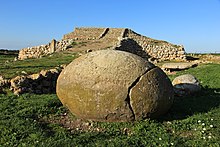
Prehistory and ancient history
Although Sassari was founded in the early Middle Ages, the surrounding area has been inhabited since the Neolithic age, and throughout ancient history, by the Nuragics and the Romans.
Many archaeological sites and ancient ruins are located inside or around the town: the prehistoric step pyramid of Monte d'Accoddi, a large number of Nuraghes and Domus de Janas (Fairy Houses), the ruins of a Roman aqueduct, the ruins of a Roman villa discovered under San Nicholas Cathedral, and a portion of the ancient road that connected the Latin city of Turris Libisonis with Caralis. In the locality of Fiume Santo is also found a fossil site where an Oreopithecus bambolii, a prehistoric anthropomorphic primate, was discovered, dated at 8.5 million years.
Middle Ages

The origin of the city remains uncertain. Among the theses, according to folk tradition the first village was founded around the 9th–10th century AD by the inhabitants of the ancient Roman port of Turris Libisonis (current Porto Torres), who sought refuge in the mainland to escape the Saracen attacks from the sea.
It developed from the merger of a number of separate villages, such as San Pietro di Silki, San Giacomo di Taniga, and San Giovanni di Bosove. The oldest mention of the village is in an 1131 document in the archive of the Monastery of St. Peter in Silki where is cited a guy named Jordi de Sassaro (George of Sassari), a serf from the nearby village of Bosove. Sassari was sacked by the Genoese in 1166.[10] Immigration continued until, in the early 13th century, it was the most populous city in the Giudicato of Torres, and its last capital. After the assassination of Michele Zanche, the latter's last ruler in 1275, Sassari became subject to the Republic of Pisa with a semi-independent status.

In 1284 the Pisans were defeated by the Genoese fleet at the Battle of Meloria, and the city was able to free itself: it became the Republic of Sassari, the first and only early independent renaissance city-state of Sardinia, with statutes of its own, allied to Genoa; the Genoese were pleased to see it thus withdrawn from Pisan control. Its statutes of 1316 are remarkable for the leniency of the penalties imposed when compared with the penal laws of the Middle Ages.[10]
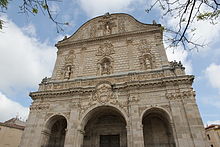
From 1323 the Republic of Sassari decided to side with the King of Aragon, in whose hands it remained for much of the following centuries, though the population revolted at least three times. The revolts ceased when King Alfonso V of Aragon nominated the town as a Royal Burg, directly ruled by the King and free from feudal taxation, during a period in which it may have been the most populous city in Sardinia. Further attempts made by Genoa to conquer the city failed. In 1391 it was conquered by Brancaleone Doria and Marianus V of Arborea, of the independent Sardinian Giudicato of Arborea, of which it became the last capital.[10] However, in 1420 the city was sold along with the remaining territory for 100,000 florins to the Crown of Aragon, replaced by Spain after 1479 on the joining of the Aragonese and Castilian thrones. During the period of Aragonese and then Spanish domination the city was known as Sàsser in Catalan language and Saçer in old Spanish.
Renaissance
The city alternated years of crisis, featuring economic exploitation, the decrease of the maritime trade, made unsafe by the daily raids of Saracen pirates, political corruption of its rulers, the sacking of Sassari in 1527 by the French, and two plagues in 1528 and 1652, with periods of cultural and economic prosperity. The Jesuits founded the first Sardinian university in Sassari in 1562. In the same year the first printing press was introduced and the ideals of Renaissance humanism became more widely known. Several artists of the Mannerist and Flemish schools practiced their art in the city.
Modern history


After the end of the Spanish period following the European wars of the early 18th century, the brief period of Austrian rule (1708–1717) was succeeded by domination by the Piedmontese, who then took over the Title of Kingdom of Sardinia (1720–1861). In 1795 an anti-feudal uprising broke out in the town, led by the Emissary of the Viceroy Giovanni Maria Angioy, a Sardinian civil servant, who later fought unsuccessfully against the house of Savoy. The city was occupied by troops at the time. The dynasty of the Piedmontese King of Sardinia went on to the monarchs of Italy. Sassari, along with the rest of Italy, became part of the newly created Kingdom of Italy.
At the end of the 18th century the university was restored. In 1836, after six hundred years, the medieval walls were partially demolished, allowing the town to expand. New urban plans were developed, on the model of the capital of the new regime's, (Turin), with geometric streets and squares.
Sassari became an important industrial center. In the 19th century it was the second most important town in what was to become the future Italy for the production of leather, and in 1848 the Sassarese entrepreneur Giovanni Antonio Sanna gained control of the mine at Montevecchio, becoming the third richest man in the new Kingdom of Italy. The first railway was opened in 1872.
In 1877 the old Aragonese castle was demolished, and on the site the "Caserma La Marmora" was built, where the headquarters of "Brigata Sassari" is still located. Founded in 1915, it still consists mainly of Sardinian soldiers.
At the end of the 19th century new urban developments grew on Cappuccini Hill and to the south of the city, architecturally dominated by Eclecticism, Art Nouveau and Art Deco styles, which created a movement towards the hybrid experimentation of new local architectural styles, known as the Sassarese Liberty.
During the Fascist dictatorship the town had over fifty thousand inhabitants and new neighbourhoods were built, the most important of these being Monte Rosello and Porcellana, typical examples of Rationalist Architecture. On the other hand, the newspaper La Nuova Sardegna, considered subversive, was closed down.
During the Second World War three Allied attempts to bomb the town failed: only the railway station was damaged, and there was only one casualty.
Today Sassari is the main cultural, administrative and historical centre of Northern Sardinia.
Culture
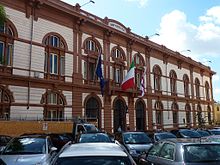
University
The University of Sassari is the oldest in Sardinia (founded by the Jesuits in 1562), and has a high reputation, especially in Jurisprudence, Veterinary Medicine, Medicine, and Agriculture. Its libraries contain a number of ancient documents, among them the condaghes, Sardinia's first legal codes and the first documents written in the Sardinian language (11th century) and the famous Carta de Logu (the constitution issued by Marianus IV of Arborea and updated later by his daughter the Giudichessa Eleanor of Arborea) in the 14th century.
The University of Sassari gained first place in 2009 in the ranking for the best “medium-sized” Italian university, awarded by the Censis Research Institute.
Language

Sassarese (Sassaresu or Turritanu) is much closer to Corsican and Tuscan language than it is to Sardinian, although this fact has caused some political controversy. It originated as a lingua franca between the first Sardinians, Corsicans, Tuscans and Ligurian people, during the period of the maritime republics. The original Tuscan structure was influenced by the Sardinian Logudorese spoken in the area, with a strong influence that can be felt in its phonetics and vocabulary, and by Catalan and Spanish in vocabulary.
Sassarese is spoken in Sassari and its immediate area by approximately 120,000 people out a total population of 175,000 inhabitants; it is also the language of the north-west of Sardinia, including Stintino, Sorso and Porto Torres; in the mid-northern areas of Sardinia, its Castellanesi dialects of Castelsardo, Tergu and Sedini are more similar to the Gallurese.
Main sights

- Archeological site of Monte d'Accoddi: a unique prehistoric monument with a step pyramid construction
- The Pisan City Walls that in the 13th century surrounded the city with 36 towers (at the moment only 6 remain), and the Catalan-Aragonese Castle named Castello di Sassari, demolished in 1877, whose ruins, including some rooms, the basement, and part of a tower were rediscovered in 2008.
- The church of St. Peter in Silki, built in the 12th century but renovated in the 17th century. Here were found the medieval codes known as Condaghe di san Pietro in Silki.
- Corso Vittorio Emanuele is the main street of the medieval town, surrounded by interesting buildings of different ages, such as several examples of Catalan-gothic (as the so-called House of Re Enzo), the baroque church of Sant' Andrea, built by Corsican community, the neoclassic Civic Theatre and Quesada's palace.
- The Cathedral of St. Nicholas of Bari, built in the 13th century and enlarged in Catalan Gothic style from 1480; there is a monument to the Duca di Moriana inside.[10] The façade, belonging to the Baroque Spanish colonial restorations of 1650–1723, has a rectangular portico surmounted by three niches housing statues of saints. The bell tower is in Romanesque style.
- The church and monastery of Santa Maria di Bètlem (13th–19th century). The original façade and parts of monastery are in Lombard Romanesque style, some chapels in International Gothic, while the rest of the building, include the big dome, was rebuilt in Baroque and Neoclassic style, by the Sardinian architect Antonio Cano in 1829–34.
- The Church of the Most Blessed Trinity contains a beautiful picture by an unknown artist of the Quattrocento.[10]
- The Cimitero comunale di Sassari (Sassari Cemetery) opened in 1837 adjacent to the Chiesa San Paolo al Cimitero just west of the main railway station
- Palazzo D'Usini, most important example of civilian architecture of the Renaissance period in Sardinia (now housing the main Public Library, therefore open to visits from the public).
- The Fountain of the Rosello, built in 1606 by Genoese craftsmen. It is made by two squared parts surmounted by two crossing arches supporting the statue of St. Gavino.
- University Palace (17th–20th century), originally a Jesuit school.
- The Ducal Palace (current Town Hall, 1775–1806), built for the Duke of the Asinara in the 18th century.
- Piazza d'Italia (19th century) is the main square in Sassari. It is surrounded by interesting buildings such as the Neo-Gothic "Palazzo Giordano" and the neoclassical "Palace of Sassari's Province", where the ancient royal apartments of the House of Savoy were once located.
- Teatro Verdi, opera house and theater for concerts and plays
Museums

- National Archaeological and Ethnographic "G.A. Sanna" Museum
- National Pinacotheca "Mus'A"
- Historical Museum of "Brigata Sassari"
- Museum of Science and Technology (it is constituted by many collections located in several university faculties: mineralogical, botanic, Entomological, zoological, anatomical collection "Luigi Rolando", physics and agronomic collection)
- Ethnographic Museum "Francesco Bande"
- Contemporary Art Museum "Masedu"
- Museum and Treasury of the Cathedral
- Museum of History of Sassari
- Museum of Sassari's Diocese
- Museum of Candelieri
- Mario Sironi art collection
- Art gallery "Giuseppe Biasi"
- Pavilion of Sardinian handicraft EXPO "I.S.O.L.A."
Festivals and traditions

- The Faradda di li candareri (The Descent of the Candelieri): it's a devotional procession, in which enormous wooden candles are carried by members of the city guilds from the town centre to the church of Santa Maria of Betlem, in commemoration of the end of the plague in 1582, but it probably has older origins, from a cultural tradition from Pisa that as early as in the second half of the 13th century was practiced in some parts of Sardinia.
- The Cavalcata Sarda (the Sardinian Cavalcade), a main event in Sardinia. On the last Sunday of May thousands of people come from all over Sardinia to Sassari to parade through the city in their local folk costumes on foot and ride on hundreds of the best Sardinian horses.
- Sardinia Film Festival was founded in 2006. With 500 films, short subjects, animated cartoons and documentaries in 2009, it has become the most prominent film festival in Sardinia.
Sport & Infrastructures
Soccer
The city of Sassari has U.S.D. Latte Dolce, the Torres Calcio Femminile that won seven Serie A titles, eight Coppa Italia, seven Supercoppa Italiana and two Italy Women's Cup. The main soccer team is S.E.F. Torres 1903 who won the two Serie C2 in 1986-87 and 1999-00. The club is also famous for lanching players like Gianfranco Zola, Pietro Paolo Virdis, Antonello Cuccureddu, Comunardo Niccolai, Theofilos Karasavvidis, Walter Mazzarri.
Basketball
Sassari has the main basketball team that Dinamo Sassari in the 2014–15 won Italian League, the club won also the Italian Cup in 2014 and 2015 and the Italian Supercup in 2014 and 2019. in 2018–19 the club won the FIBA Europe Cup.
Infrastructures
The city has the main Stadio Vanni Sanna where it is held some concerts and where plays the Torres Calcio Femminile, S.E.F. Torres 1903 and U.S.D. Latte Dolce. The Palasport Roberta Serradimigni is the indor basketball arena where the basketball team of Dinamo Sassari plays and where it is held some concerts.
Notable people
Notable people born here include the former presidents of the Italian Republic, Antonio Segni and Francesco Cossiga, and Enrico Berlinguer, secretary of the Italian Communist Party.
Sassari is also the birthplace of Domenico Alberto Azuni, a jurist expert in commercial law.
Personalities
|
Notable historical personages
|
Contemporary personalities
|
Government

The Municipal Council of Sassari is led by a left-wing majority, first elected in May 2005 and confirmed in 2010 and 2014. The mayor is Nicola Sanna, member of the Democratic Party.
Administrative subdivision
The Municipality of Sassari was subdivided into ten circoscrizioni (administrative districts), reduced to six since the elections of May 3, 2000, and four since the elections of May 31, 2010.
| Circoscrizioni | Population | Neighborhoods included |
|---|---|---|
| 1° Circoscrizione | 62,981 | Center, Carbonazzi, Porcellana, Rizzeddu, Monserrato, San Giuseppe, Cappuccini, Luna e Sole |
| 2° Circoscrizione | 37,814 | Latte Dolce, Monte Rosello, Santa Maria di Pisa |
| 3° Circoscrizione | 24,969 | Bancali, Caniga, La Landrigga, Li Punti, Ottava, Pian di Sorres, San Giovanni, Sant'Orsola |
| 4° Circoscrizione | 3,258 | Argentiera, Villassunta, Biancareddu, Campanedda, Canaglia, La Corte, La Pedraia, Palmadula, Tottubella, Rumanedda |
Economy
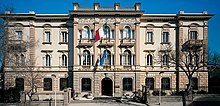
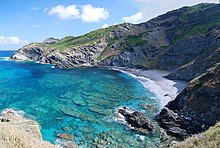
The economy of town is mainly focused on services and the advanced tertiary sector. It is the principal administrative centre of central and northern Sardinia. The main Sardinian banks (Banco di Sardegna and Banca di Sassari) have head office and presidency in the city.
Several research centers are located in town: the University ones, the Center of Regional Weather Service (Meteo Sar.), the Regional Agency for Environmental Protection (ARPA), the Zooprophylaxis Institute of Sardinia, and many labs of the National Research Center (CNR): the Institute of Biometeorology (IBIMET), the Institute of Biomolecular Chemistry (ICB), the Institute of Ecosystem Studies (ISE), the Institute of Sciences of Food Production (ISPA), and the Institute for Animal Production System in Mediterranean Environment (ISPAAM).
Manufacturing includes construction, pharmaceutical, food, typographic industry, and also, indirectly, petrochemical and the new greenchemicals located in Porto Torres.
Tourism is concentrated mainly along the coasts. Platamona, Porto Ferro, Porto Palmas and Argentiera are the principal seaside tourist spots of the municipality.
Average income in Sassari is 24,006 euros per person.[12]
Transportation

The nearest airport, Fertilia International Airport, is 25 km (16 mi) from the city center, and the closest seaport is located at Porto Torres, 16 km (10 mi) away.
Urban and suburban public transport is operated by about 25 bus lines of Azienda Trasporti Pubblici (ATP) and by a light rail transit of Azienda Regionale Sarda Trasporti (ARST). Two different railway companies connect the town to the rest of the island: Trenitalia links Sassari to Porto Torres, Oristano, Cagliari, Olbia, Golfo Aranci, and the ARST reaches Alghero, Sorso, Nulvi and Palau.
Dual carriage motorways link Sassari to Porto Torres, Platamona, Cagliari (SS131), Olbia (SS199) and to Alghero (SS291). High-capacity traffic roads connect Sassari to Tempio Pausania (SS672) and Ittiri.
Sport

- A.S.D. Torres Calcio football club, founded in 1903, playing in Serie C
- Torres Calcio Femminile women's football club, playing in Serie B, winners of seven national championships and eight national cups.
- Dinamo Basket Sassari, playing in Lega Basket Serie A
- HC Tangram 1 Sassari women's team handball club, playing in Serie A1
- Yellow Team Sassari Baseball, playing in Serie C1
- Sassari Baseball Softball Club, playing in serie C2
- A.S.D. Rugby Sassari, playing in Serie C
Consulates
 France
France Spain
Spain
Twin towns – sister cities
Sassari is twinned with:
 Gorizia, Italy, since 1983
Gorizia, Italy, since 1983 Timișoara, Romania, since 1990
Timișoara, Romania, since 1990 Gubbio, Italy, since 2002, between the Faradda and the Saint Ubaldo Day
Gubbio, Italy, since 2002, between the Faradda and the Saint Ubaldo Day Viterbo, Italy, since 2006, between the Faradda and the Macchina di Santa Rosa
Viterbo, Italy, since 2006, between the Faradda and the Macchina di Santa Rosa Nola, Italy, since 2006, between the Faradda and the Festa dei Gigli
Nola, Italy, since 2006, between the Faradda and the Festa dei Gigli Palmi, Italy since 2006, between the Faradda and the Varia di Palmi
Palmi, Italy since 2006, between the Faradda and the Varia di Palmi Napoli, Italy since 2009, between the Faradda and the Dedication of Saint Mary Major
Napoli, Italy since 2009, between the Faradda and the Dedication of Saint Mary Major Campobasso, Italy since 2009, between the Faradda and the Festival dei Misteri
Campobasso, Italy since 2009, between the Faradda and the Festival dei Misteri Barcelona, Spain, since 2010 ("artistic twinning")
Barcelona, Spain, since 2010 ("artistic twinning")
See also
- Sassarese language
- Province of Sassari
- University of Sassari
- Sassari Mechanized Brigade
References
- "Superficie di Comuni Province e Regioni italiane al 9 ottobre 2011". Italian National Institute of Statistics. Retrieved 16 March 2019.
- "Statistiche demografiche ISTAT". Retrieved 1 January 2017.
- "Sassari". The American Heritage Dictionary of the English Language (5th ed.). HarperCollins. Retrieved 5 May 2019.
- "Sassari". Merriam-Webster Dictionary. Retrieved 5 May 2019.
- "Statistiche demografiche ISTAT". Retrieved 1 January 2017.
- "Archived copy". Archived from the original on 2015-09-03. Retrieved 2016-09-26.
{{cite web}}: CS1 maint: archived copy as title (link) - "Neoclassical – Artistic – Itineraries – Sardinia Tourism". Sardegnaturismo.it. Retrieved 2011-09-16.
- "Sassari – History and culture". Sardegna.net. Retrieved 2011-09-16.
- "Climate Statistics for Sassari, Sardinia". Retrieved November 23, 2012.
-
 One or more of the preceding sentences incorporates text from a publication now in the public domain: Herbermann, Charles, ed. (1913). "Sassari". Catholic Encyclopedia. New York: Robert Appleton Company.
One or more of the preceding sentences incorporates text from a publication now in the public domain: Herbermann, Charles, ed. (1913). "Sassari". Catholic Encyclopedia. New York: Robert Appleton Company. - "With him is his cohort Michel Zanche of Logodoro, and their tongues never tire with constant chatter about Sardinia."
- "Cagliari, cresce il reddito pro capite E' al 13° posto nella classifica nazionale – Cronache dalla Sardegna – L'Unione Sarda.it". 29 March 2011. Retrieved 1 January 2017.
External links
На других языках
[de] Sassari
Sassari (sassaresisch: Sassari; sardisch: Tàtari/Tàttari/Tàthari) ist mit 126.218 Einwohnern (Stand 31. Dezember 2019) die zweitgrößte Stadt Sardiniens. Sassari liegt im Norden der Insel und ist Hauptstadt der gleichnamigen Metropolitanstadt Sassari. Die angrenzende Gemeinden sind Alghero, Muros, Olmedo, Osilo, Ossi, Porto Torres, Sennori, Sorso, Stintino, Tissi, Uri und Usini.- [en] Sassari
[es] Sácer
Sácer [1][4][5][6][7] (en italiano, Sassari; en sardo, Tàtari; en sassarés, Sàssari) es una ciudad italiana ubicada en Cerdeña, capital de la provincia homónima, segunda ciudad de la isla después de Cáller. Se encuentra situada a 35 kilómetros del Aeropuerto de Alguer-Fertilia.[ru] Сассари
Са́ссари (итал. Sassari, сард. Tàtari) — город в итальянском регионе Сардиния, административный центр одноимённой провинции, второй по величине и значению в регионе после столицы Кальяри.Другой контент может иметь иную лицензию. Перед использованием материалов сайта WikiSort.org внимательно изучите правила лицензирования конкретных элементов наполнения сайта.
WikiSort.org - проект по пересортировке и дополнению контента Википедии


